Drawing dandelions is useful for children of different ages. This activity promotes the development of thinking, helps to develop perseverance and attentiveness. Parents need to know what materials and tools may be required for drawing, look at several step-by-step master classes and choose a picture to copy.
What do you need for drawing?
The list of necessary tools and materials for drawing can be found in the table.
| Simple pencils | You need 3 pencils of different degrees of hardness: hard, soft, hard-soft. |
| Sharpener | To draw thin and graceful lines, you need to use sharp pencils. |
| Eraser | It is advisable to purchase a double-sided eraser with a soft and rough end to effectively remove pencil lines of different thicknesses. |
| Gel pens | They may be needed to work out small details and perform final tracing. |
| Art brushes | To paint plants you need thin brushes with soft bristles, as well as medium-thick brushes with short and hard bristles. |
You can color the drawing with paints, colored pencils, pens or markers.
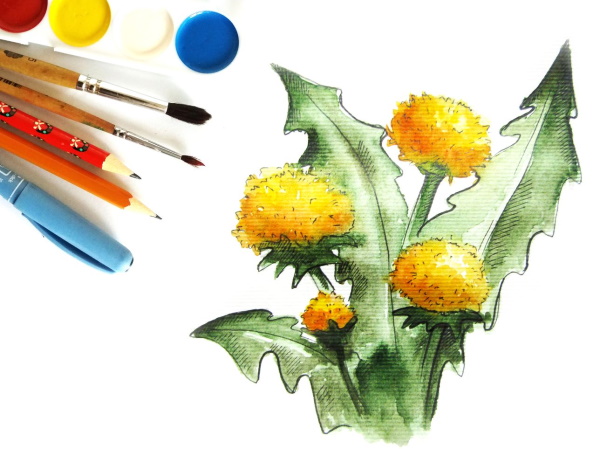
What colors do artists use to paint dandelions:
- dark green;
- light green;
- yellow;
- orange;
- white;
- grey;
- brown.
Paints differ from each other in texture, so they will look different on paper. For example, a watercolor drawing will be gentle, without rough lines and bright shades. The colors will merge and smoothly transition from one to another. Gouache is a brighter and thicker paint, but when it dries, it becomes lighter by 2 tones.
To obtain rich shades, the picture is painted in 2 layers.
Step by step instructions on how to draw a dandelion with a pencil
Dandelion (a drawing for children over 10 years old should be detailed) should be drawn with sharp pencils so that the lines are thin and graceful. In the picture, you can depict 2 stages of flower development at once: a bud and an inflorescence with seeds. You also need to draw a leaf of the plant with large teeth.
Sketch
Drawing should begin with marking the contours of the flower. For this, you need a hard pencil.
Procedure:
- Draw 1 vertical line from the center of the sheet from the bottom up. It should not be straight, as if drawn with a ruler. On the contrary, it should be smooth, slightly curved. This is the base of the dandelion stem. These flowers do not grow straight. Their stems bend from the weight of the inflorescences and take a curved shape.
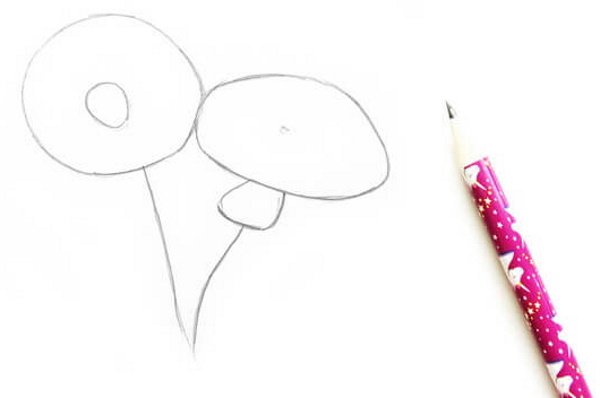
- Draw another line next to it. This will be the 2nd stem for another inflorescence. It can be drawn shorter or longer than the first. It is important that the stems come out from 1 point at the bottom and diverge in different directions at the top. The distance between their pinwheels should be such that the flowers drawn next do not intersect with each other.
- Draw a 3rd line on the opposite side. It should be slightly shorter than the previous 2. Its top should be moved away from the others.
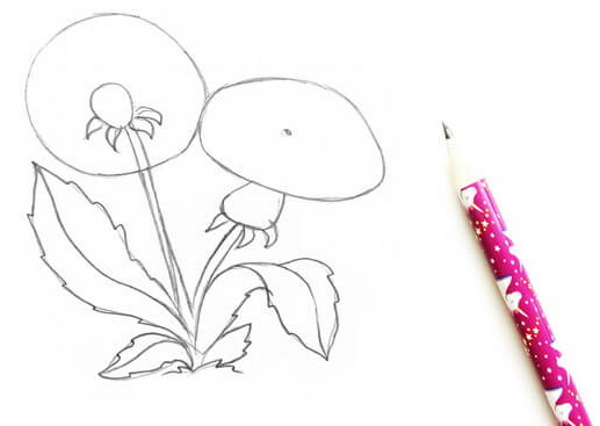
- The last line drawn is the middle of the dandelion leaf. Now you need to give it shape, indicating wide teeth on both sides, as well as a sharp tip.
- Above line 1, outline the shape of a fluffy cap with seeds. This should be done with thin, broken strokes.
- Above the 2nd line, draw the shape of an unopened bud.
A sketch helps to maintain correct proportions and correctly place all the small details in the drawing. When creating a sketch, you cannot press on the pencil. The lead should barely touch the paper and leave almost invisible traces.
Once all the details have been drawn on the picture, the lines made with a hard pencil will need to be erased. If the sketch is rich and clear, it will be difficult to remove it. The result will be a dirty drawing.
Detailing
All details should be drawn with a hard-soft pencil.
Procedure:
- Next to each line that imitates the shape of the stem, you need to draw another parallel line. It is important that it repeats all the bends. The distance between these lines should be small. They are needed to make the flower stem voluminous.
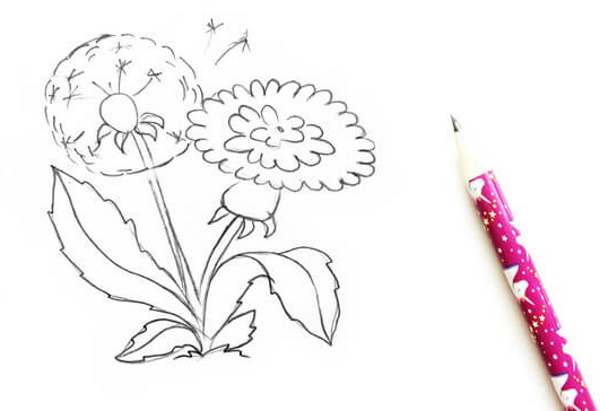
- Draw sepals on the tops of the stems. They should not be straight either. Let the petals bend and twist in different directions. There should be 3-4 petals on 1 sepal.
- Where the shape of the bud is indicated, you need to draw folded leaves, and at the top, protruding ends of the petals.
- Above the 2nd stem there will be a cap with seeds, so first you need to draw the core of the flower. It has an oval shape and protrudes above the surface of the sepal.
- Now from this core you need to draw many small lines of different sizes. They should stick out in different directions.

- Using a hard pencil, draw some fluff at the top of each line.
- Above the fluffy cap, you can depict flying seeds that have calved from the flower. First, draw a line, add fluff on top, and draw an elongated seed below, using a soft pencil. The seeds should fly in different directions.
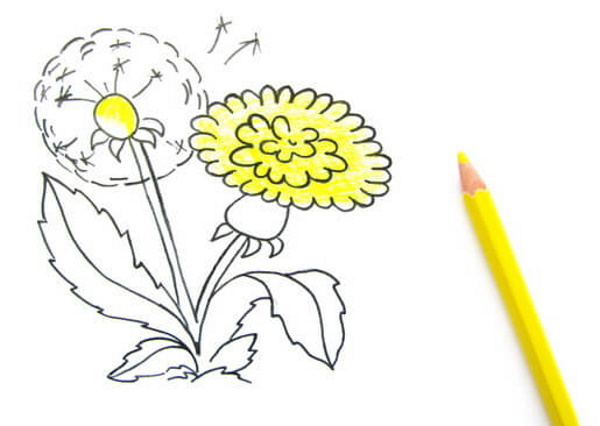
- Draw veins on the flower leaf.
The connection of the stems at the bottom can be covered with drawn grass. All unnecessary lines can be removed with an eraser.
Hatching
To make the drawing look three-dimensional, you need to depict shadows. They are applied with strokes using a soft pencil.
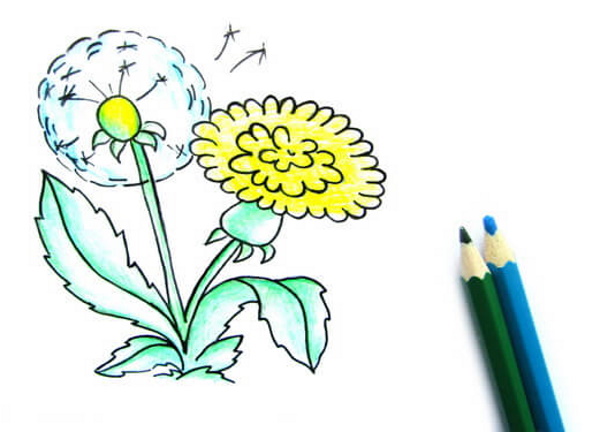
Procedure:
- Shade the area under the flower.
- Apply horizontal strokes to 1 side of the stem.
- Mark the shadow under the sepals.
- Darken the middle of the sheet.
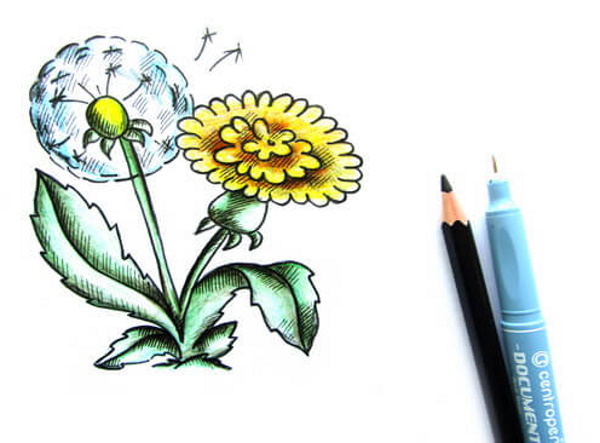
Rub all the strokes carefully with your fingers. To blend the pencil inside the stem, you can use a cotton swab.
Step by step instructions on how to paint a dandelion
Dandelion (a drawing for younger children should be easy to do) can be painted with paints. To depict flowers with fluffy seed heads, it is better to use colored paper, since on ordinary white sheets the light paint will be poorly visible.
In this master class, a sheet of blue cardboard was used as a background, and the drawing was done with gouache.
Sketch
Use a hard pencil to make a sketch.
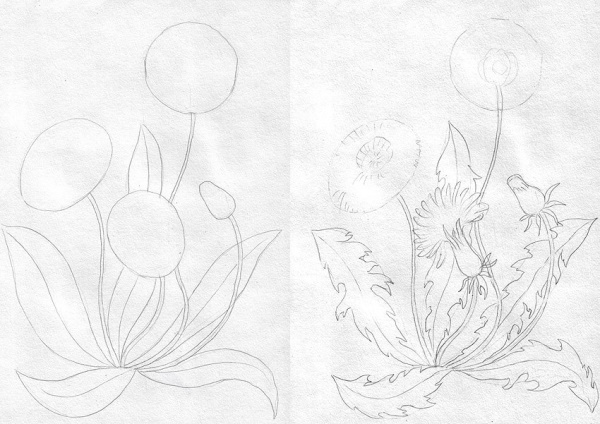
Algorithm of actions:
- 1 Use a thin line to outline the shape of the stem.
- Draw a circle on the top of the stem. This will be the core of the flower.
- Use short strokes to outline the shape of the seed head.
- Draw a leaf of the plant.
At this stage, there is no need to erase extra lines.
Detailing
Details are drawn with a hard-soft pencil.

Procedure:
- Draw veins on the leaf.
- Add volume to the stem by drawing a parallel line next to the intended line.
- The sepals are depicted using straight and thick lines.
- Draw small lines from the center of the circle. Draw fluff on top.
- Next to the flower, depict flown seeds with fluff. Let some of them fly, and the other part lie under the flower.
All lines should be thin so that they can be easily covered with paint.
Coloring
You will need thin and medium-thick brushes.
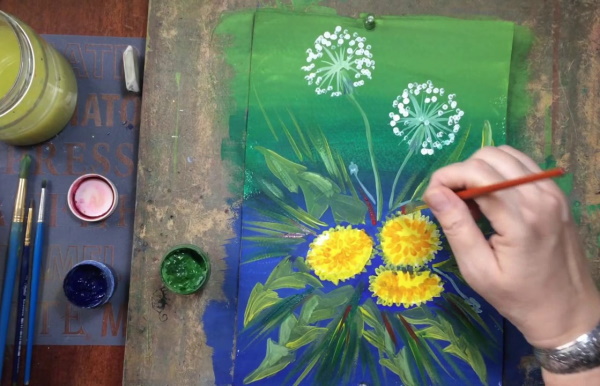
Procedure:
- Using a medium-thick brush, pick up some light green paint and paint the leaf.
- Paint the stem dark green.
- Paint the core of the dandelion with brown paint.
- Wait until the paints dry.
- Take a thin brush, dip it in dark green color, and draw the veins on the leaf, and also outline it with a zigzag line.
- Trace the sepal.
- Wash the brush, pick up some light green color, and apply a few short strokes along the entire length of the stem on 1 side.
- Wash the brush thoroughly. Take white paint and outline all the "parachutes" on the seed cap.
- Circle all the flying seeds.
When the white paint dries, you need to wet the brush in brown gouache and draw elongated seeds on each individual “parachute”.
Pattern variations
Dandelion (a drawing for children under 5 years old should be done together with parents) can be drawn using different materials. Small children can be offered to draw an outline picture with felt-tip pens or with their fingers, using special paints.
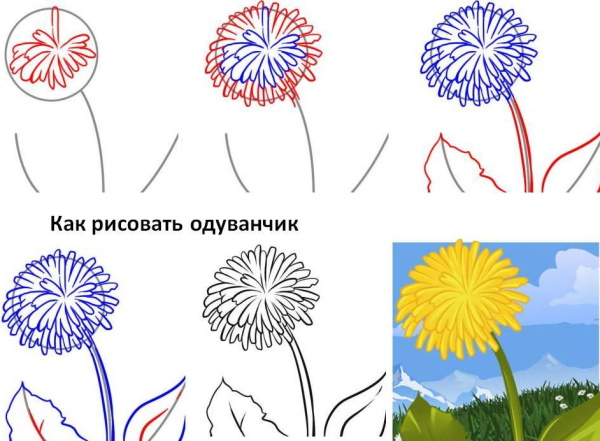
These drawing techniques will help develop perseverance and hand-eye coordination in children. Older children need to learn to combine different shades and carefully apply lines of different thicknesses. You can use paints, pencils, and colored pens for this.
Yellow dandelions painted with acrylic paints
Acrylic paints are good because they have a bright and saturated palette. They are easy to apply to paper, the colors mix well and do not lighten when dry. This master class describes a simple drawing that can be done without a pencil sketch.
This technique is suitable for children from 3 to 7 years old.
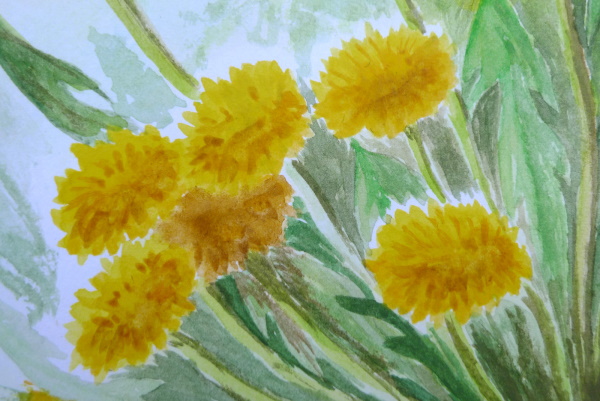
How to paint a dandelion with acrylic paints:
- Using a medium-thick brush, pick up some light green paint and draw 2 stems.
- Draw a slightly thinner line next to it. This will be the middle of the plant leaf.
- Give the leaf shape. Draw large zigzag corners and a sharp tip.
- Paint the leaf with light green paint.
- At the top of the stem, depict the core of the flower in the form of a circle.
- Wait until the paints are completely dry.
- Using a thin brush, pick up some dark green color and outline the leaf and the stems of the dandelion.
- Draw veins on the sheet.
- Wash the brush in clean water, take orange color, and draw several short petals. They should be narrow and sticking out in different directions.
- Dry the paint. Then take yellow with a brush and paint many yellow petals. The dandelion head will resemble a hedgehog with long needles.
You can use dark green paint to paint the sepal underneath the flower.
How to Paint a Dandelion Field in Watercolor
You can draw a field of dandelions on an A4 sheet of paper either schematically or in more detail. Option 1 is suitable for preschool children.
Procedure:
- Wet a sheet of paper with a wide, clean brush.
- Using a medium-thick brush, pick up some blue color and paint half of the sheet with horizontal strokes.
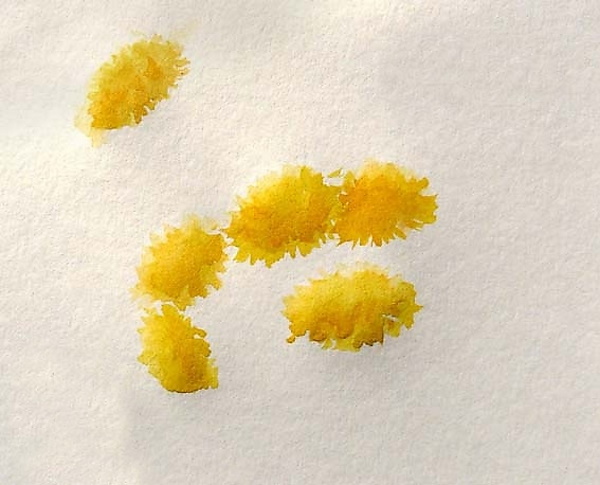
- Wash the brush, take some green paint. Paint the other part of the sheet with vertical strokes.

- Dry the paper. Take a medium-thick brush with hard bristles. Pick up some yellow paint and use dabbing motions to depict several flowers on a green background.
- Draw white flowers in the same way.
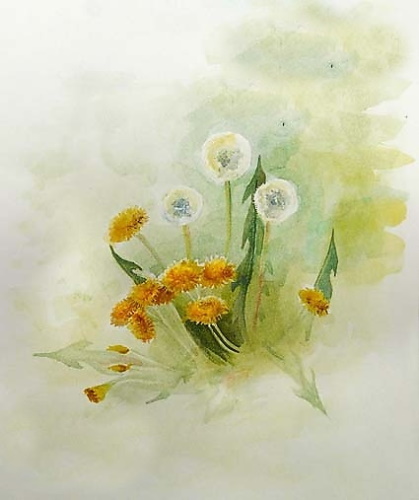
The next master class is for children over 7 years old. First you need to make a background.
Same as in the previous version: wet the paper, paint the top of the sheet blue and the bottom green. Dry the drawing.
What to do next:
- Dip a thin brush in dark green watercolor and paint dandelion stems and blades of grass.
- Use light green paint to mark the sepals on the stems and the cores of the flowers.
- Take a medium-thick brush with hard bristles, dip it in white paint, and paint the white caps of the flowers with dabbing movements. The white paint should not get on the cores.
- Dry the drawing.

- Take a black gel pen and draw 3-5 short lines inside the white caps. They will imitate the legs of the "parachutes".
- Dilute blue paint with water in a 1:1 ratio and stir.
- Wet a thin brush with soft bristles in this water and outline each hat with a dotted line.
- Dilute black paint with water in a 1:1 ratio, then use a thin brush dipped in this water to put 3-5 dots near the core of each flower. They will imitate seeds.
Using a thin brush, you need to finish drawing the blades of grass on the background, using light green watercolor. Dry the drawing.
Bouquet of dandelions drawn with colored pencils
To get a rich drawing, you need acrylic pencils. Their graphite is softer, it is easy to rub, and the colors mix better. Ordinary colored pencils are not as bright, they are more difficult to shade.

How to draw a bouquet of dandelions in a glass:
- Use a simple hard pencil to make a sketch of the glass in which the bouquet will stand. First, you need to draw an oval located horizontally. From its ends, draw 2 straight lines down. Draw the bottom of the glass. Mark the water level inside.
- Trace the sketch with a blue pencil.
- Add some blue strokes where the water should be.
- Draw 7-9 flowers with a yellow pencil. Petals can be depicted as strokes of different sizes that will come out from 1 point in different directions.
- Using a light green pencil, draw the leaves and sepals sticking out of the bouquet.
- Draw stems in the glass. In the part where the water is drawn, the stems need to be made a little thicker.
- Use a dark green pencil to outline the stems and also draw the veins on the leaves.
- Apply a few strokes of orange to the center of each flower.
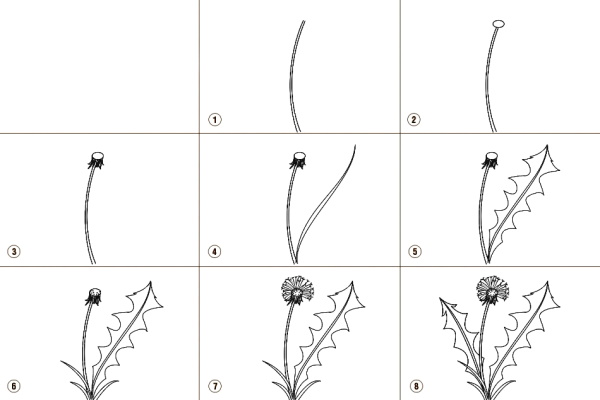
Use a cotton swab to blend the outline of the glass, as well as the part of the stems that are immersed in water.
Dandelion with white pen on dark background
Dandelion (a drawing for children from 4 years old can be an outline, without small elements and mixed colors) can be drawn with a white pen. Such a picture is suitable for decorating a postcard or a wall panel.
Black, blue, brown or purple cardboard is suitable for the basis of the drawing.
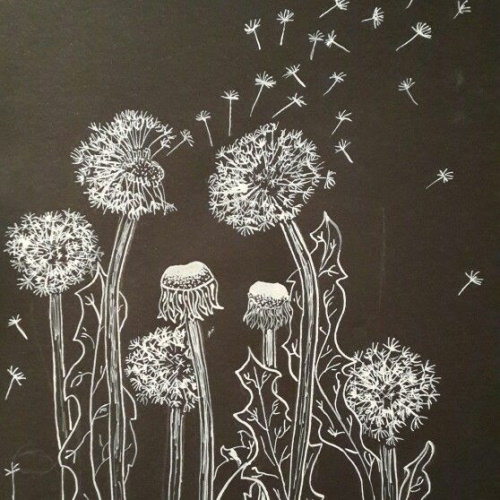
How to draw:
- Draw the stem.
- At the top of the stem, depict the core of the flower.
- Use short, straight strokes to outline the sepal.
- Shade the stem with zigzag lines.
- Draw a white cap with seeds. From the middle, draw many short lines of different sizes, draw fluff.
- Draw flying seeds next to the dandelion.
The white pen can be replaced with a thin brush and white acrylic paint.
Finger painting
Children under 3 years old can be offered to draw a dandelion with their fingers. This will require special paints that do not cause allergies on the skin and are easily washed off with water.

How to draw:
- Use your finger to pick up some light green paint and draw the stem of the flower, as well as the blades of grass around it.
- Use brown paint to depict the center of the dandelion. To do this, dip your finger in the paint and imprint it on the top of the stem.
- Let the drawing dry.
- Dip your index finger in white paint and use poking motions to depict fluff on a dandelion. The more dots, the more lush the flower.
- Next to the replacement hat, depict flying “parachutes” in the form of single fingerprints.
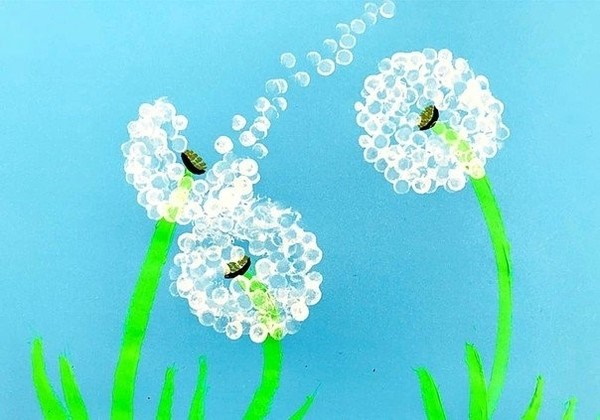
Finger paint can be washed off your hands with wet wipes.
How to draw a dandelion with markers
Using felt-tip pens, you can draw a simple but colorful picture.
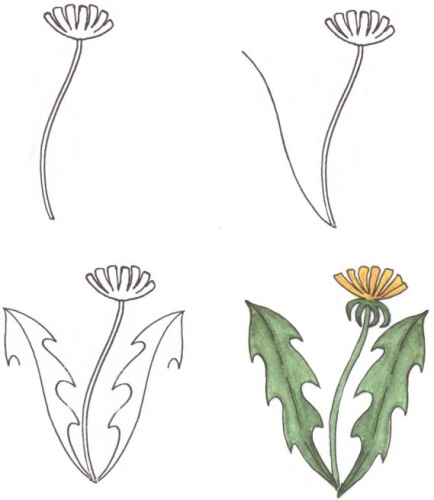
How to draw a dandelion:
- Draw the stem in dark green.
- Draw the flower's core as a circle using a brown marker.
- Take a light green marker and use short, straight strokes to outline the sepal.
- Shade the stem with zigzag lines.
- Draw a hat with seeds in grey and add some fluff.
- Draw flying seeds next to the dandelion. Color the seeds with a brown marker.
You can draw a yellow dandelion by depicting petals with long strokes coming out from the center of the flower and sticking out in different directions.
Examples of images for copying, tips for beginners
To draw a neat and beautiful picture, you need to know a few secrets:
- Younger children find it easier to draw on A3 paper. It is difficult for them to draw small details, especially with their fingers. There is more space on such sheets than on standard album pages.
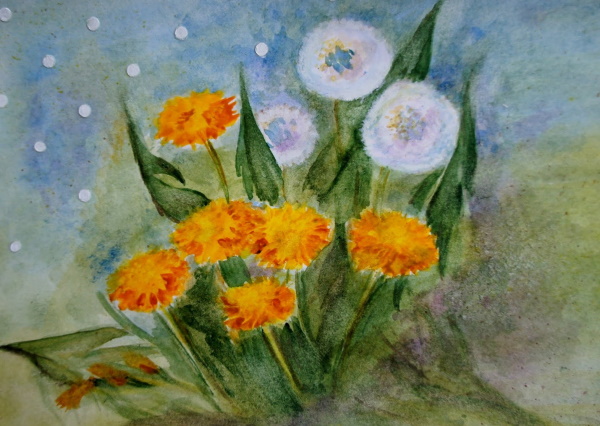
- If you don't have a white pen or white paint on hand, you can replace them with a corrector.
- To prevent the sheet of paper from sliding around on the table, you can secure it with small pieces of tape at the corners.
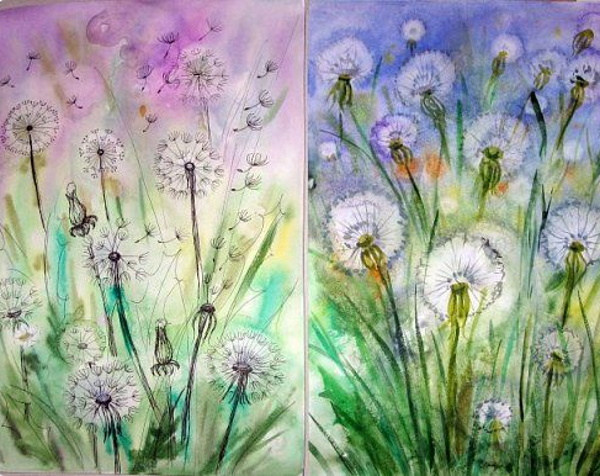
- In schematic drawings, it is not necessary to draw each dandelion "parachute" separately. Instead, you can wet the brush in white paint and, holding it over the paper, move it with your fingers. Small dots will imitate flying seeds.
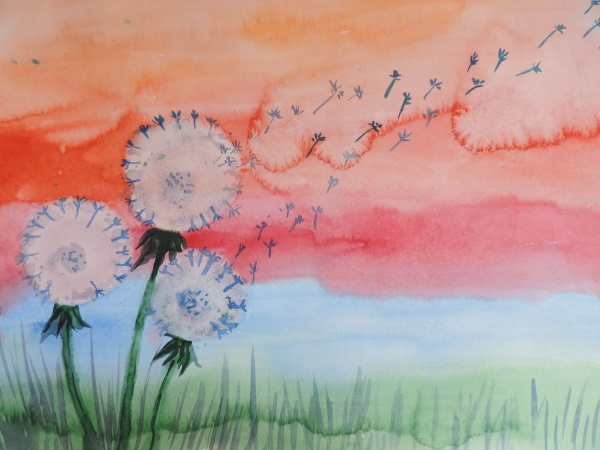
Drawing dandelions will help children develop fine motor skills and expand their knowledge of these plants. Parents should work with their children and comment on the drawing process to maintain the child's interest.
It is necessary to explain what the different parts of the plant are called, how seeds are spread, and why dandelions come in 2 colors. The picture for copying can be chosen from the options presented in the article.
Video about drawing a dandelion
Master class on drawing dandelions:
